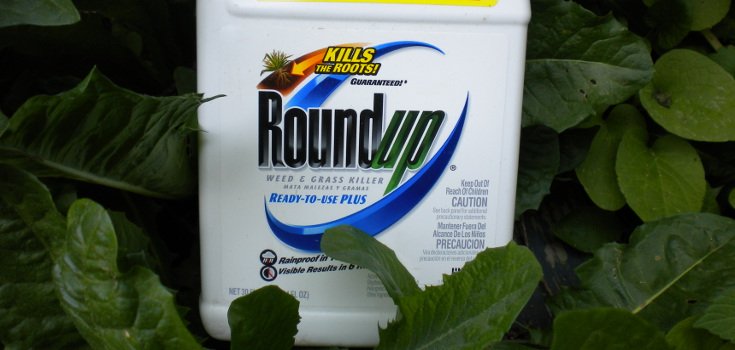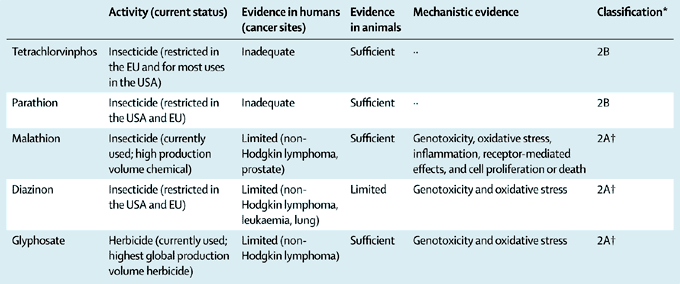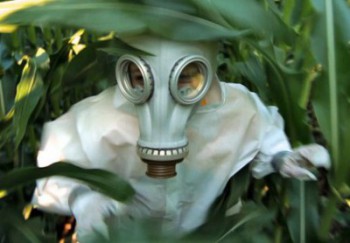17 Scientists Speak Out: Monsanto’s Roundup is Causing Cancer

Are the full body protective suits not enough of a tip off that pesticides are toxic? If not, consider this: Monsanto’s Roundup herbicide – the most widely used and best-selling herbicide in the U.S. and one of the world’s most popular weed-killers – has been labeled a probable carcinogen by the International Agency for Research on Cancer.
The decision was made by IARC, the France-based cancer research arm of the World Health Organization, which considered the status of five insect and weed killers including glyphosate, which is used globally in industrial farming.
As reported by The Lancet:
“In March, 2015, 17 experts from 11 countries met at the International Agency for Research on Cancer (IARC; Lyon, France) to assess the carcinogenicity of the organophosphate pesticides tetrachlorvinphos, parathion, malathion, diazinon, and glyphosate (table). These assessments will be published as volume 112 of the IARC Monographs.”

After analysis, it was determined that glyphosate falls into the 2nd level of concern (mainly at industrial use) of 4 levels for possible cancer-causing substances. The 4 levels are:
- Known carcinogens,
- Probable or possible carcinogens (where glyphosate stands)
- Not classifiable
- Probably not carcinogenic
The U.S. Environmental Protection Agency said it would consider the French agency’s evaluation. But given US government agencies’ decisions and political ties, hope is dismal that they will do anything to limit its use. The EPA’s 2012 assessment of glyphosate concluded that it met the statutory safety standards and that the chemical could “continue to be used without unreasonable risks to people or the environment.”
Read: Study Finds Roundup Chemicals Lethal in Small Doses
Though the agency analyzed numerous weed killers, glyphosate, being one of the most popular, is of greater concern. This active ingredient found in Monsanto’s Roundup herbicide currently holds the highest production volumes of any herbicide, used in more than 750 different products. Unfortunately, its use has skyrocketed in recent years due to the development of herbicide-resistant genetically modified crops – made to withstand copious amounts of herbicide spraying.

Though the ill effects from glyphosate exposure are most said to be concerning for occupational workers, tests revealing how ubiquitous the chemical really is should pave way for widespread concern.
Not only has glyphosate been detected in the air, in the water, and in our food, but it is also showing up in humans – despite the claims from Monsanto that the chemical is excreted from our bodies. Numerous studies have shown that not only is it causing numerous health problems, but it is showing up in urine samples, blood samples, and even breast milk. This is concerning.
“Glyphosate has been detected in the blood and urine of agricultural workers, indicating absorption. Soil microbes degrade glyphosate to aminomethylphosphoric acid (AMPA). Blood AMPA detection after poisonings suggests intestinal microbial metabolism in humans. Glyphosate and glyphosate formulations induced DNA and chromosomal damage in mammals, and in human and animal cells in vitro.
One study reported increases in blood markers of chromosomal damage (micronuclei) in residents of several communities after spraying of glyphosate formulations. Bacterial mutagenesis tests were negative. Glyphosate, glyphosate formulations, and AMPA induced oxidative stress in rodents and in vitro. The Working Group classified glyphosate as “probably carcinogenic to humans.”
Needless to say, Roundup creator and biotech giant Monsanto strongly disagreed with the decision.
“All labeled uses of glyphosate are safe for human health,” said Phil Miller, a Monsanto spokesman, in a statement.
Scientists Have Warned for Years that Monsanto’s Roundup Causes Cancer
Backing up the World Health Organization’s recent re-classification, a professor in the Department of Ecotoxicology at the National University of Littoral in Argentina and researcher from the primary national research council of Argentina, CONICET, says that “the international scientific community has warned for years, backed up by studies, that glyphosate is carcinogenic. It is good that WHO has recognized this fact.”
EWG: Monsanto’s Herbicide Chemical Glyphosate Doubles Cancer Risk
The Environmental Working Group (EWG) points out that the IARC’s most recent report confirmed the findings of the Agency’s previous meta-analysis, which combined the results of several studies and concluded that farmers and others exposed to glyphosate suffer double the risk of developing non-Hodgkin’s lymphoma.
The more recent report also highlighted studies that found that farm workers’ glyphosate exposure increases their risk of multiple myeloma by 70 to 100%.

#1 – Saccharin
Did you know Monsanto got started because of an artificial sweetener?
John Francisco Queeny founded Monsanto Chemical Works in St. Louis, Missouri with the goal of producing saccharin for Coca-Cola. In stark contrast to its sweet beginnings, studies performed during the early 1970s,* including a study by the National Cancer Institute in 1980, showed that saccharin caused cancer in test rats and mice.
After mounting pressure from consumers, the Calorie Control Council, and manufacturers of artificial sweeteners and diet sodas, along with additional studies (several conducted by the sugar and sweetener industry) that reported flaws in the 1970s studies, saccharin was delisted from the NIH’s
Carcinogen List. A variety of letters from scientists advised against delisting; the official document includes the following wording to this day: “although it is impossible to absolutely conclude that it
poses no threat to human health, sodium saccharin is not reasonably anticipated to be a human carcinogen under conditions of general usage as an artificial sweetener.”
#2 – PCBs
During the early 1920s, Monsanto began expanding their chemical production into polychlorinated biphenyls (PCBs) to produce coolant fluids for electrical transformers, capacitors, and electric motors. Fifty years later, toxicity tests began reporting serious health effects from PCBs in laboratory rats exposed to the chemical.
After another decade of studies, the truth could no longer be contained: the U.S. Environmental Protection Agency (EPA) published a reportciting PCBs as the cause of cancer in animals, with additional evidence that they can cause cancer in humans. Additional peer-reviewed health studies showed a causal link between exposure to PCBs and non-Hodgkin Lymphoma, a frequently fatal form of cancer.
In 1979, the United States Congress recognized PCBs as a significant environmental toxin and persistent organic pollutant, and banned its production in the U.S. By then Monsanto already had manufacturing plants abroad, so they weren’t entirely stopped until the Stockholm
Convention on Persistent Organic Pollutants banned PCBs globally in
2001.
And that’s when Monsanto’s duplicity was uncovered: internal company memos from 1956 surfaced, proving that Monsanto had known about dangers of PCBs from early on.
In 2003, Monsanto paid out over $600 million to residents of Anniston, Alabama, who experienced severe health problems including liver disease, neurological disorders and cancer after being exposed to PCBs — more than double the payoff that was awarded in
the case against Pacific Gas & Electric made famous by the movie “Erin Brockovich.”
And yet the damage persists: nearly 30 years after PCBs have been banned from the U.S., they are still showing up in the blood of pregnant women, as reported in a 2011 study by the University of California San Francisco; while other studies are indicating a parallel between PCBs and autism.
#3 – Polystyrene
In 1941, Monsanto began focusing on plastics and synthetic polystyrene, which is still widely used in food packaging and ranked 5th in the EPA’s 1980s listing of chemicals whose production generates the most total hazardous waste.
Lots of hate for Monsanto here.. Pretty entertaining..
What good have they done? Anyone?